Westringia plants are worthwhile additions to any Australian garden. These native shrubs have garnered popularity thanks to their hardy qualities, attractive features and low-maintenance requirements.
Whether you’re looking for a functional or ornamental addition to your garden, one of these luscious plants may be the perfect pick for you. Here is your full guide to growing and caring for Westringia.
More...
Genus: | Westringia |
|---|---|
Species: | Many available |
Family: | Lamiaceae |
Location: | Outdoor |
Type: | Shrub |
Growth: | Multiple sizes depending on the variety |
Sun requirements: | Full sun to part shade |
Foliage Colour: | Green |
Flower Colour: | Mauve, blue-purple, white |
Flowering: | Spring |
Maintenance level: | Low |
Poisonous for pets: | Non-toxic to cats and dogs |
Getting to Know Westringia
Westringias have become widely used in gardens across the country, serving many purposes within landscapes. Being rapid growing plants with abundant blooms and dense foliage, the westringias are also known to grow in a variety of conditions and they are well-suited to our sometimes more challenging environments.
Thanks to the frequent and easy flowering nature of these natives, they have become popular choices for avid and new gardeners alike.

Part of the Lamiaceae family, members of the Westringia species sit comfortably in many garden styles and several of the more cultivated varieties are commonly known as Coastal Rosemary.
The 33 species of shrubs are all native to Australia, commonly occurring in most states except the Northern territory. These shrubs are naturally tolerant to a variety of growing conditions and are known to be fast-growers.
Plant sizes will vary depending on which variety of Westringia you grow but either way, these bushy natives are excellent and vibrant additions to the garden.
Westringias feature fast-growing, grey to deep green foliage and delicate mauve, blue-purple or white blooms depending on the variety. In some areas, these plants can flower prolifically throughout the year but are commonly known to bloom each spring.
Despite being known as local rosemary or mint, the plants and flowers don’t have a particularly strong aroma but they do retain a healthy bushy appearance for many years.
Enjoying this non-invasive native in your landscape will come easily and won’t require a lot of hassle.
Common Westringia Landscaping Positions

You can use the clean, vibrant variegated foliage to easily spruce up your natural spaces and the local wildlife will love your westringia, where it will be frequently visited by bees, butterflies and birdlife.
Here are some popular uses of westringia:
- Ornamental shrubs to fill out sparse flowerbeds
- Feature plant in native gardens
- Rapid growing groundcover
- Bushy and colourful hedging or screening
- Natural boundaries for retaining walls
- Embankment plantings
- Large container plants
- General garden edging
- Box or topiary projects
Popular Westringias to Grow in Australia
Some Westringia species are more widely cultivated than others, many of which are also hybrids. These hybrids are specifically cultivated for certain purposes like formal hedging and box or topiary projects.
All of these plants can feature different growing habits and flower colours so be sure to find the right variety for your gardening needs. Some popular species include:


Get Your Free Guide:
Master Growing Australian Natives eBook
A Must Have Complete Guide for Every Australian Garden
Get Your Free Guide:
Master Growing Australian Natives eBook
A Must Have Complete Guide for Every Australian Garden
Coastal Rosemary | 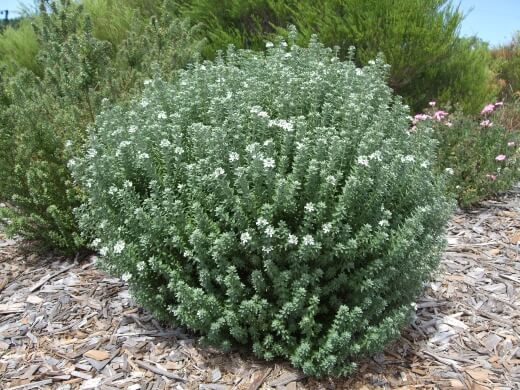 Source: andreasensgreen.com.au |
Violet Westringia | 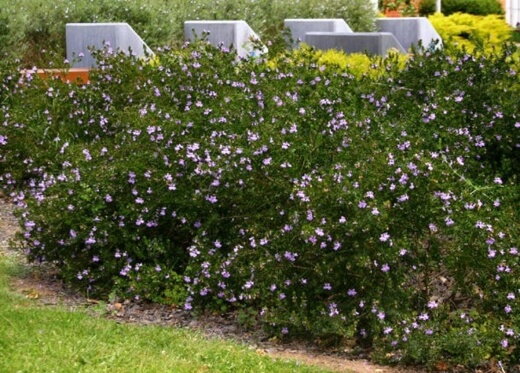 Source: plantmark.com.au |
Long-leaved Westringia (Westringia longifolia)Commonly known as long-leaved westringia, this variety is endemic to south-eastern Australia and features linear leaves and mostly white flowers. Average growth is 1 to 3 metres tall and wide. | 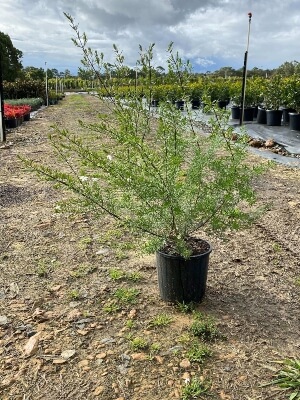 Source: andreasensgreen.com.au |
Coastal Rosemary (Westringia fruticosa)

Source: andreasensgreen.com.au
Being the most commonly cultivated variety of westringia, especially for hedging, this plant has many hybrid cultivars all known as coastal rosemary.
Producing white flowers with purply spots, this variety grows to around 1 to 2 metres high and almost twice as wide. Check out our comprehensive growing guide for Westringia fruticosa.
Violet Westringia (Westringia glabra)

Source: plantmark.com.au
This variety features delicate bright-purple flowers and glossy green foliage. It is a smaller growing variety that makes for a great landscaping plant.
Long-leaved Westringia (Westringia longifolia)

Source: andreasensgreen.com.au
Commonly known as long-leaved westringia, this variety is endemic to south-eastern Australia and features linear leaves and mostly white flowers. Average growth is 1 to 3 metres tall and wide.
How to Grow Westringia in Australia
Young and healthy plants can be purchased from reputable local nurseries or westringias can be propagated using cuttings. It is not recommended to try growing them from seeds as this is not a reliable way to ensure the quality of the species or cultivars.
It is recommended to grow or propagate these shrubs in spring as the roots will develop faster in warmer conditions.
Westringia Propagation
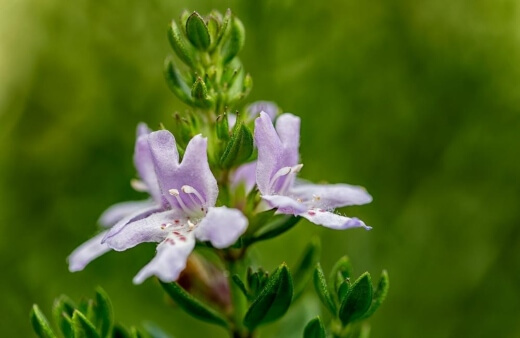
Propagating Westringia Using Cuttings
- Select healthy young stems to take cuttings from.
- Using sharp and sterile garden shears, take a cutting by snipping below a leaf node on your stem and remove the foliage from the bottom two nodes.
- It is recommended to take multiple cuttings as there might be some losses along the way.
- Place your cuttings into well-draining containers or growing trays filled with a potting mix of 90% perlite and 10% peat moss. The sections of the cuttings that were stripped away should be placed into the soil mix.
- Water well after planting and keep your propagation mix lightly moist at all times being careful not to let it dry out.
- Place your cuttings in a well lit but sheltered location away from direct sunlight or strong winds.
- Roots will start to develop in around two to three months depending on temperatures.
- Once your cuttings have good healthy root development you can plant them as desired in organic soil rich in nutrients.
It is important to note that these plants can struggle to establish themselves in cooler climates so be patient and you should have a healthy plant in no time.
In the past, we suggested the use of peat/sphagnum moss. But, in light of its environmental impact, we've adjusted our recommendations to favor more eco-friendly alternatives that are equally or even more effective. Be sure to read our guide If you're interested in exploring peat moss and its substitutes.
Westringia Planting Guide
Westringias are great additions for the overall health of Australian gardens. These hardy natives can thrive in many different locations in landscapes as long as frequent exposure to frost is avoided.
Whether you live in an arid or coastal region, westringias should be able to establish themselves in your landscape. Be sure to water your plant well after planting.
Whether planted directly into your garden or used as a large container plant, there are naturally certain conditions that will allow your westringia to grow best.
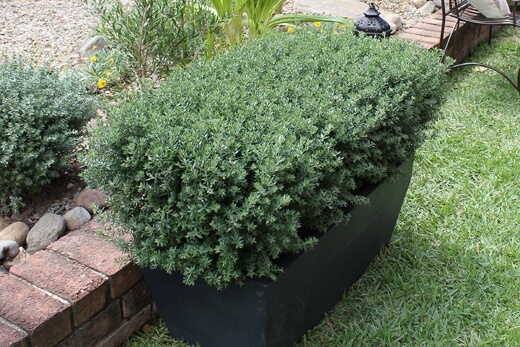
Source: screenhedgeplants.com.au
Ideal Lighting Condition
These plants grow best in full sun positions but they can also grow in partially shaded locations.
Best Soil for Westringia
These plants have adapted to many different soil types so they can grow in most soils as long as they are fast-draining. These plants do not enjoy wet feet.
How to Plant Westringias
Planting Westringia in the Garden
- Choose a spot in your garden that gets full sun to part shade.
- Dig a planting hole twice as wide and to the same depth as the root ball.
- Gently remove your plant from its current container and lightly tousle the roots with your fingers to remove old soil. Try disturbing the roots as little as possible.
- Gently position your plant in the hole and slowly backfill with your soil. Lightly firm the soil around the plant with your palms being sure not to overly compact it.
- Water well after planting to settle the soil around the roots.
- Mulch around but not too close to the base of the plant with organic mulch.
- Keep the soil moist for several weeks to help the plant establish itself.
- You can optionally add a native fertiliser occasionally to ensure strong root development.
Planting Westringia in a Container
- Choose a pot or container that is well-draining and at least twice the size of your plant.
- Fill your new container with a quality potting mix and dig a hole at least twice the size of the root ball.
- Carefully remove your plant from its current container being sure to disturb the roots as little as possible.
- Position in your hole and backfill with your potting mix.
- Gently firm down and water in well.
- Mulch around but not too close to the base of the plant with organic mulch.
- Keep your soil lightly moist but not waterlogged.
How to Care for Westringia
Once established, these plants are tolerant to cold, drought and moisture but they do not enjoy long exposure to freezing temperatures or icy winds. Overall, these natives are especially low-maintenance and easy-going in Australian gardens.
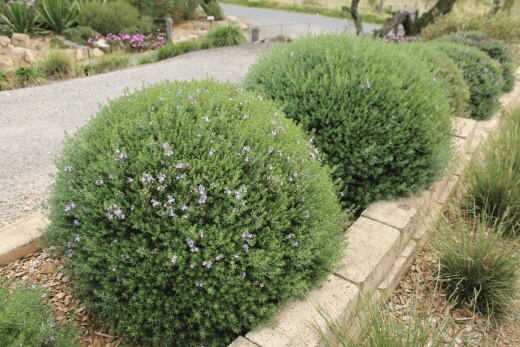
Source: ozbreed.com.au
Watering Needs
Water to keep your soil slightly moist but not wet as these plants don’t like sitting with wet feet. They generally have low water needs so be careful not to overwater as this can lead to root rot issues.
Pruning Westringias
These plants will respond best to light pruning done during spring to early summer. Try only cutting back soft, leafy growth and not too much hardwood.
Hard, vigorous pruning can lead to stunted growth so this should be avoided as much as possible. For westringia hedge pruning, a frequent but light routine is great to keep tidy and encourage denser growth.
See our review on the best hedge shears to help you get that perfect hedge every time.
What Fertiliser to Use
Though not necessary, you can feed your plants annually in early spring with specifically designed native plant food or an organic-based fertiliser.
Popular Westringia Hedge & Screen
These bushy shrubs make for excellent native hedge plants. Great for coastal or arid areas and relaxed or formal garden settings, these plants are widely used for their hedging and screening abilities.
They are very drought-tolerant plants which means they are also very water-wise options.

Source: alpinenurseries.com.au
Here are some popular westringia cultivars for hedging and screening:
- Westringia fruticosa ‘Smokey’ – This plant features hardy qualities and subtle, silvery-green variegated foliage.
- Westringia fruticosa ‘Seafoam Swell’ – The ideal compact growth habit and profuse flowering of this plant are what make it such a popular hedging option.
- Westringia fruticosa ‘Naringa’ – Perfect for taller westringia hedges and screens, this variety will grow to about 1 to 2 metres and is naturally dense and compact.
- Aussie Box Westringia – A hybrid cultivar that makes for an excellent medium hedging option with masses of mauve flowers and luscious green foliage.
Plant at least 50cm apart for hedges and screens. Larger growing varieties can be planted further apart whereas the dwarf varieties will need to be planted closer together.
Check out our guide for more in-depth information on other excellent Australian native hedge plants.
Common Pets, Problems & Diseases
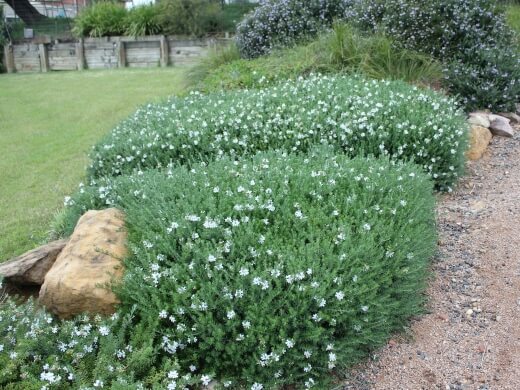
Source: diacos.com.au
Luckily, these natives are rarely affected by pests or diseases. The only issue that is common with these plants is overwatering which can quickly lead to root rot.
You will know your plant is suffering from root rot if the roots start to look black and feel mushy. Healthy roots may still appear dark or pale but they will feel firm and pliable to the touch.
To treat root rot, you can clean the roots under running water and then gently remove the affected areas of the root system. Discard your old soil and replenish your bed or container with fresh organic soil.
Wash your pots and equipment and water your plant well. It should be able to recover soon with some extra care.
Westringia Frequently Asked Questions
Are Westringia roots invasive?
The westringia root systems are regarded as non-invasive and safe for planting near paved or built-up areas.
How tall do westringias grow?
On average, these plants grow to around three metres tall. There are naturally taller growing varieties as well as a few dwarf varieties to choose from.
Why is my Westringia going yellow?
This could indicate that there is too much phosphorus in your soil which can poison many native plants. If the leaves of your plant are yellowing, this could also indicate that your soil is deficient in iron or that the pH balance is incorrect.
In severe cases, use soil testing kits to see how you can improve your soil quality.
For more information on growing Australian natives, be sure to have a look at our helpful guide below:

Add some Native Wonder to your Landscape with Westringia
Offering growers so much variety and functionality within their gardens and natural spaces, these hardy native shrubs are an easy choice if you’re looking for a vibrant and fast-growing plant that flowers abundantly and requires little effort.
Seamlessly blending into formal or relaxed gardens, the Westringia plants are also perfectly suited to the Australian climates. Add some wild native wonder to your garden with one of the stunning Westringia varieties.
Published on May 8, 2022 by Lorri Hopkins
Last Updated on February 21, 2024



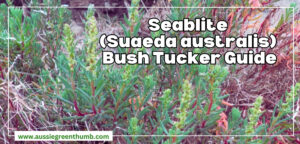
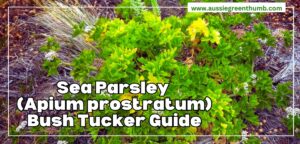
Hi there,
I have been searching your site for some tips on what may be wrong with my beautiful aprox 3 year old Westringia Glabra. Some of the top branches seem to be dying and the leaves are turning brown.
I'm not sure what to do as I absolutely hate to lose this plant 🙁 which I use for screening. It is aprox 3 metres tall & 1.5 metres wide. I don't think it is overwatering but the plant is on irrigation over the hotter months in (Melbourne). It also is planted east facing and seems to get a good amount of sun as it is so big and lush otherwise.
It recently (over the past 5/6 or so months) suffered a bout of scale (white soft scale) which I now have under control with horticultural/neem oil and one dose of Richgro bug killa. The Westringia Wynyabbie gem next to it was treated with the same products and it's doing fine.
I am getting the soil tested by the EPA, awaiting report (desperate to find out what could be the problem and save the plant) . What trace elements should I look for that may be a problem, potassium, iron etc??
Can you direct me to any information you have on this topic that I may have overlooked? Any information would be so appreciated.
Cheers!
Hi Deanne,
As a general rule, Westringia shouldn’t need watering once they’re established. They need plenty of water to begin with to help roots settle in, and the odd drink during droughts is useful, but regular irrigation other than rainfall might not be helping.
If they’ve got brown sections, it’s probably caused by root rot rather than an infection of the top growth, especially if it’s covering large areas of the plant.
The first thing you’ll need to do is cut out any of the brown, dead, material. It won’t recover, and cutting back to healthy growth will help (and stop anything potentially nasty spreading further). Then, like you say, it could be worth adding nutrients, but rather than worrying about specifics, just add liquid seaweed.
Let it dry out for a week or two first so the roots can breathe and are forced to put on new growth, then add liquid seaweed (not a fertiliser, but improves the soil itself and unlocks any nutrients that are inaccessible). If that helps at all, then add a general-purpose organic fertiliser. The organic feeds have the micronutrients and minerals that chemical feeds don’t.
I hope that helps! Keep us posted!
Lorri Hopkins
Thanks for your professional advice.
Around early March I cut back the dead branches to the green growth anyway. At the time I did check the base of the plant again and the soil seemed very dry at the time but have also turned off the irrigation.
At that time I also applied Seasol and an organic fertilizer. Since then the Westringia has put on some new growth. Mainly towards the middle to lower section of the plant, but also a little on the top which is hopefully a good sign.
With the weather now getting cooler, the plant has seemed to stabilize (so no real dead branches have formed since) Of course, I probably will get more dead branches over the winter months. I have been keeping a close eye on it and can see that the scale has also gone…..thankfully.
May do well with a good prune in the springtime???
Hi Deanne,
I’m so thrilled to hear it’s stabilised since summer. Any soil improver will have helped with drainage problems (seasol’s a great choice!). The fact it put on new growth is really promising too. That implies there’s new roots, or at least healthy and happy roots down there.
As long as it doesn’t get too wet over winter it should be fine. I’d be surprised if there was anything other than lush new growth come spring, so then it’s up to you whether you prune it. It would help the new roots out, and could create a bushier plant (probably for the best after a year of struggling growth and pruning).
Best regards,
Lorri Hopkins